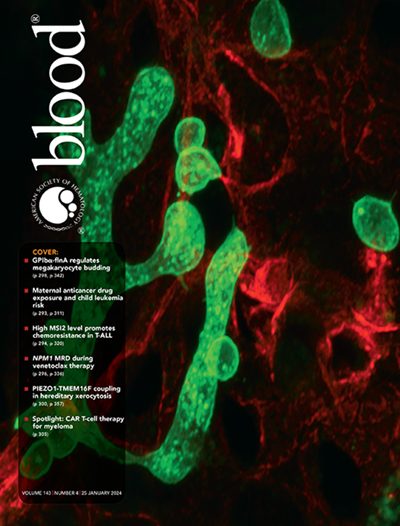骨髓瘤演变和结果的免疫改变:现状?
IF 21
1区 医学
Q1 HEMATOLOGY
引用次数: 0
摘要
多发性骨髓瘤(MM)及其前体意义不明的单克隆γ病(MGUS)的发病机制与衰老的免疫系统有关。B/浆细胞的慢性活化可能有助于MGUS的起源,这在老年人中很常见。然而,每年只有1%的MGUS患者进展为MM。免疫系统可以特异性识别MGUS病变,临床前MM模型为先天和适应性免疫监测提供了证据。多组学研究已经确定了MGUS阶段的几个系统性改变,表明在演变为临床恶性肿瘤之前加速了免疫衰老。MM进一步与肿瘤生长模式的空间改变和区域免疫的原位调节有关。肿瘤和微环境相关因素都有助于免疫麻痹,从而促进克隆浆细胞的传播,增加MM患者感染的风险。血液或骨髓中的免疫谱表现出相当大的异质性,并与包括T细胞重定向在内的免疫治疗后的结果有关。了解潜在的全身免疫变化如何影响体内天然或合成肿瘤/抗原特异性免疫的功能和持久性,需要进一步研究。在预防临床MM和治疗活动性疾病的背景下,保持或恢复免疫功能可能对长期结果至关重要。需要对免疫生物标志物进行基准测试,然后将其前瞻性地整合到当前的风险模型中,同时提高对体内肿瘤免疫机制的理解,以优化免疫方法并改善MM的预后。本文章由计算机程序翻译,如有差异,请以英文原文为准。
Immune Alterations in Myeloma Evolution and Outcomes: Quo Vadis?
The pathogenesis of multiple myeloma (MM) and its precursor monoclonal gammopathy of undetermined significance (MGUS) is linked to an aging immune system. Chronic activation of B/plasma cells may contribute to the origin of MGUS, which is frequent in the elderly. However, only 1% of individuals with MGUS annually experience progression to MM. The immune system can specifically recognize MGUS lesions and preclinical MM models provide evidence for both innate and adaptive immune surveillance. Multiomic studies have identified several systemic alterations at the MGUS stage, suggesting accelerated immune aging prior to evolution into clinical malignancy. MM is further associated with spatial alterations in patterns of tumor growth and in-situ regulation of regional immunity. Both tumor and microenvironment-related factors contribute to immune paresis, which facilitates the dissemination of clonal plasma cells and increases the risk of infections in MM patients. Immune profiles in blood or marrow exhibit considerable heterogeneity and have been linked to outcomes following immune therapies including T cell redirection. Understanding how underlying systemic immune changes impact in-vivo function and durability of natural or synthetic tumor/antigen-specific immunity needs further study. Preserving or restoring immune function may be critical for long-term outcomes both in the context of prevention of clinical MM and of treating active disease. Benchmarking of immune biomarkers followed by its prospective integration into current risk models, together with improved understanding of mechanisms underlying tumor immunity in-vivo, are needed to optimize immune approaches and improve outcomes in MM.
求助全文
通过发布文献求助,成功后即可免费获取论文全文。
去求助
来源期刊

Blood
医学-血液学
CiteScore
23.60
自引率
3.90%
发文量
955
审稿时长
1 months
期刊介绍:
Blood, the official journal of the American Society of Hematology, published online and in print, provides an international forum for the publication of original articles describing basic laboratory, translational, and clinical investigations in hematology. Primary research articles will be published under the following scientific categories: Clinical Trials and Observations; Gene Therapy; Hematopoiesis and Stem Cells; Immunobiology and Immunotherapy scope; Myeloid Neoplasia; Lymphoid Neoplasia; Phagocytes, Granulocytes and Myelopoiesis; Platelets and Thrombopoiesis; Red Cells, Iron and Erythropoiesis; Thrombosis and Hemostasis; Transfusion Medicine; Transplantation; and Vascular Biology. Papers can be listed under more than one category as appropriate.
 求助内容:
求助内容: 应助结果提醒方式:
应助结果提醒方式:


